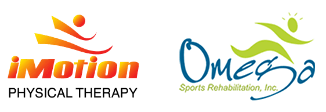Have you ever felt the sensation that an electric shock is going from your lower back to your legs? Ever experience weakness in your muscles or numbness in your arms and legs? If you’ve answered yes to either of those questions, it’s time to schedule your free consultation with iMotion Physical Therapy to see a physical therapist…you might have a herniated disc.
What Does It Mean To Have a Herniated Disc?
The spine is comprised of vertebrae that are cushioned by flat, round discs. These discs have an outer layer called the annulus, which surround a gel-like material called the nucleus. Discs are located in between each of the vertebrae in spinal column. Their main job is to act as little shock absorbers for your spine.
You might have heard a herniated disc be referred to as a “ruptured” or “bulged” disc. This issue happens when the disc nucleus gets moved out of the annulus and into the spinal canal – which has limited space as it is!
Because of this movement, the displacement often causes pain. A herniated disc can occur literally anywhere in the spine, from the lower part of your back to the cervical spine areas.
How To Know If You Have a Herniated Disc
Herniated discs can happen for a number of reasons, including a strain or an injury of some sort. Some people are actually predisposed for herniated discs depending on genetics, and some people naturally experience herniated discs naturally as they age.
As a person gets older, disc material slowly degenerates. Ligaments will start to grow weaker, and when this happens, even the smallest of movements (such as twisting or stretching) can result in a herniated disc.
The signs of a herniated disc are different depending on the size of the disc and its location. If the disc is not pushing on a nerve, you might not feel any pain, but if it is on a nerve, there will be pain, weakness, and a feeling of numbness in the part of the body where the nerve is being pressed on.
When there is pressure being applied to the sciatic nerve, a condition called sciatica make occur in the lower lumbar spine. Sciatica causes sensations of pain, burning, and numbness ranging from the buttocks, down the legs, and to the feet. A sharp pain may also be felt when walking, sitting, or standing.
You may feel pain in the neck and between your shoulder blades if a herniated disc occurs in the neck area. This pain will most likely be felt down your arms and into your fingers. Needless to say, a herniated disc in any part of your body can cause a lot of discomfort.
Physical Therapy Can Alleviate The Pain
If you’re suffering from a herniated disc or pressure on your sciatic nerve, your doctor may refer you to a physical therapist. Your therapist will do a thorough examination for you and create a specialized treatment plan that will directly address the pain associated with your condition.
Physical therapy might include massage, ice or heat therapy, pelvic traction and ultrasound, and of course, stretching exercises.
Physical therapy can play a massive role in getting on the road to recovering from a herniated disc. It entails a holistic approach with active and passive treatments. A physical therapist will not only provide pain relief for you, but they’ll also be able to teach you how to prevent this kind of injury in the future.
Call today to schedule your first appointment and learn more about safe and effective ways to reduce and alleviate your back pain!
Sources:
- https://www.aans.org/en/Patients/Neurosurgical-Conditions-and-Treatments/Herniated-Disc
- https://www.spineuniverse.com/conditions/herniated-disc/physical-therapy-herniated-discs
Tags: health, fitness, Imotion Physical Therapy, back pain, Herniated Disc, ice or heat therapy, massage, Physical Therapy, pelvic traction, physical therapist, ultrasound, Health and Wellness, stretching exercises, physical fitness


